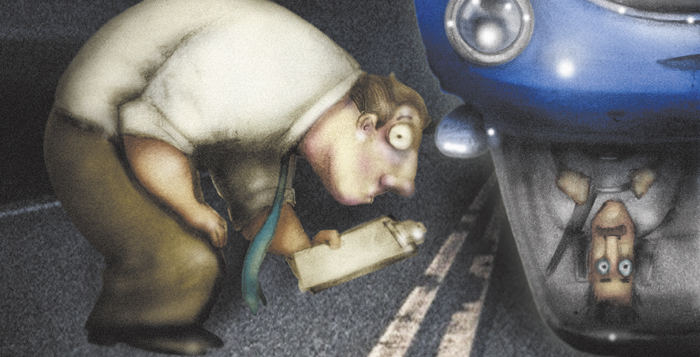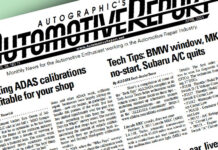By John Yoswick
It’s easy as a shop owner to get so caught up in day-to-day operations that it can be a challenge to follow just the news directly affecting collision repairers. But there is also plenty of “insurance-related” news that shops also should know about, because it can help them educate their customers, market their business, and maybe even alter how they vote or shop for insurance themselves.
Here are some recent auto insurance industry news items and trends and what they could mean for collision repairers.
Crack-down on uninsured
Insured cars are far more likely to be repaired after an accident, so any efforts to improve compliance with insurance mandates are generally good news for collision repair shops. Tennessee this year is finalizing a new system designed to reduce the state’s chronically-high percentage of uninsured drivers. By early next year, a new verification system is slated to be in place that will run vehicle registrations periodically to check for insurance. Owners of uninsured vehicles will have 15 days to provide proof of insurance or face fees that start at $25 but jump to $100 (along with a suspension of registration) for a second notice. Those caught driving without insurance also will face fines of $100 to $300, and police will have the authority to have uninsured vehicles towed.
One in every five Tennessee drivers lacks insurance, according to 2012 numbers from the Insurance Research Council, the sixth-highest percentage among all 50 states.
Accident frequency varies widely by market
Do customers in your market have an accident on average every four years – or every 13 years? There’s that much of a spread, according to the latest report (http://tinyurl.com/BestDrivers) from Allstate ranking 200 cities based on accident rates.
For the first time in the 11 years that the insurer has produced the study, Kansas City, Kan., is listed at No. 1, even when the listing is adjusted to account for precipitation. Kansas City drivers average a whopping 13.3 years between accidents, much longer than the national average of 10 years.
Other cities on the list include No. 13 Montgomery, Ala., (11.4 years between accidents), No. 29 Knoxville, Tenn., (10.6 years between accidents), No. 60 Indianapolis, Ind., (9.4 years between accidents), No. 69 Louisville, Ky., (9.2 years between accidents), No. 130 Little Rock, Ark., (8.2 years between accidents) and No. 200 Boston (just 3.9 years between accidents).
Do insurers want to be “steered”
Many shops believe they have had customers steered to another shop by an insurance company; the insurance industry portrays “shop referrals” very differently, and recently issued survey findings that they say backs up their view.
The Insurance Information Institute’s 2015 survey of 1,015 adults found that 79 percent said they want their insurer to recommend a repair shop. What’s more, the survey results state, if choosing between a repair shop of their own choice or an insurer-recommended shop, 72 percent said they would be more likely to use the recommended shop.
The survey also found that two-thirds (64 percent) of consumers say they would use non-OEM parts if paying for vehicle damage themselves.
The full survey report (including a list of the questions asked) is available at the Institute’s website (www.iii.org). Of course, while at the website, it’s worth checking out the list of the companies the association represents: primarily insurers doing business in North America.
‘Grading insurers’ over time
Changes in an insurance company’s claims handling practices are generally gradual, so shops might not realize that, over time, an insurer has actually become easier or better to work with — or has headed in the opposite direction. That’s why one study asking shops over the course of more than a decade to rate the insurers they work with offers an interesting look at such gradual change over time.
Progressive Insurance, for example, must be doing something right in the eyes of collision repairers in the Pacific Northwest. Over the past decade, the insurer has steadily improved its “policies, attitude and payment practices [to] ensure quality repairs and customer service for Oregon motorists,” according to shop surveys conducted by the Northwest Automotive Trades Association (NATA).
The association since 2004 has asked Oregon shops to grade the Top 20 auto insurers in the state in terms of how well each company’s policies ensure a quality repair. Not only has Progressive steadily improved each year, it is the only insurer to have made such dramatic improvements, raising its grade from a D+ in 2004 to a C+ in 2015, making it now the third-best major insurer in the state — and the sixth best overall — in terms of taking care of drivers following an accident.
State Farm’s grade has been heading the opposite direction. For nearly 10 years, from 2004 to 2013, the insurer held the top spot in the survey findings. But in 2014, just after rollout of the PartsTrader program, State Farm’s score declined more than one full grade, to a C+ in 2014, rising just slightly in 2015 to a B-.
State Farm’s decline has allowed two consistently top-graded regional carriers, Oregon Mutual and Mutual of Enumclaw, to take over the top spots in the most recent survey. In 2015, the top five insurers were Oregon Mutual (B+), Mutual of Enumclaw (B), State Farm (B-), USAA (B-), and Kemper/Unitrin (C+). Progressive placed sixth with a C+ grade.
At the other end of the spectrum, Geico, a perennial low scorer, fell to last place, earning a C- from shops, with Liberty Mutual, Safeco, Farmers and Allstate rounding out the bottom five with a C or lower. And according to NATA, one in five shops gave an F grade to Geico, Safeco, Allstate and Farmers.
Regulators take on insurer conduct
Shops often complain that state departments of insurance too often in disputes side with insurers rather than shops or consumers. But there are notable exceptions.
Shop and consumer complaints over several years, for example, led the California Department of Insurance last fall to accuse three insurance companies of unfair or deceptive practices related to shop labor rates.
The allegations against Allstate Insurance, for example, include several incidents in which the insurer was willing to pay only a fraction of a shop’s labor rate, yet “had not conducted a labor rate survey or provided any other credible evidence that the labor rate used to cap or deny the portion of the claim was reasonable within [the shop’s] geographic area.” In one such incident, which resulted in a consumer complaint, Allstate allegedly told the insured the lower rate it was willing to pay was the “prevailing labor rate,” which the Department says was “untrue, deceptive and misleading” because it was not supported by a labor rate survey or other credible evidence.
In other similar instances, only after the Department of Insurance intervened did Allstate conduct labor rate surveys, which did result in increases in the labor rate it was willing to pay; yet in these incidents, the Department notes, Allstate did not provide any credible evidence that its “initial capping and denying of the labor rate was reasonable.”
The allegations against Allstate cite five such incidents in all, and the Department has also filed similar allegations against Alliance United Insurance (two such incidents) and Sterling Casualty Insurance (one such incident). Penalties can include fines of up to $5,000 per incident ($10,000 per incident if the acts are found to be “willful”).
No more ‘in-on-Monday, out-on-Friday’
Involvement by the Connecticut Insurance Department also ensured shops there know that USAA no longer pushes shops to bring all consumers’ vehicles into the shop early in the week.
The regulator last year fined USAA Insurance $95,500 after a market conduct examination found that, among other violations, the company told some claimants that they could not drop their car off for repairs on a Thursday or Friday. That’s a common practice by insurers in many markets because late-in-the-week drop-offs can extend rental of a replacement vehicle through a weekend when the car is not being repaired.
But Connecticut regulators say such a limit on policyholders violates section 38a-816 of the state’s unfair insurance practices act.
In USAA’s response filed with the Connecticut Insurance Department, the insurer says the claims in question occurred prior to a change in the company’s procedure which now allows coverage of a rental car “without limitations to a particular day of the week.”
Shops are right to question anything they get in writing from insurers about late-in-the-week scheduling. In 2014, CRASH Network reported on a similar issue with Farmers Insurance in which the company directed its DRP shops to advise customers that they would be charged for weekend rentals if they drop their car off on a Friday when work would not begin until Monday. After CRASH Network contacted Farmers about it, the company said the memo was a mistake and “is contrary to our policies and procedures.”
Shops should also be heartened by the fact that some insurance company representatives recognize the potential problems by limiting late-in-the-week drop-offs. Speaking at NACE last summer, Chris Andreoli, repairer network process director at Progressive Insurance, agreed that scheduling is an issue within his company’s DRP.
“That’s more of a ‘we’ problem than a ‘you’ problem,” Andreoli told repairers at the event. “We certainly cause those issues, the old ‘in on Monday, out on Friday,’ rather than just getting things level. That’s definitely something that could be worked on.”
Allstate sees dollar signs in data
Allstate last year was issued a patent proposing to use sensors, cameras and other devices to monitor just about everything going on in a vehicle, from seat position and stereo volume, to the number and ages of occupants and potential sources of driver distraction. The patent discusses a broad set of data the insurer would like to gather, including the driver’s phone use and eating habits while driving, any alcohol content in the air, and even the driver’s eyeline, head position, heart rate and blood pressure.
The patent, called “traffic-based driving analysis,” even envisions gathering information on nearby vehicles so the carrier can compare its policyholders’ habits to other drivers in the area.
“So my car spies on me and on other drivers near me?” said Bob Hunter, insurance director for the Consumer Federation of America and a former Texas insurance commissioner, in an interview with the Chicago Tribune after reviewing the patent. “Even if I give permission for this intrusive technology, my car spies on unsuspecting passengers and even on unsuspecting pedestrians or cars passing by?”
The patent, which Allstate said it filed a few years ago, was issued just a few months after Allstate CEO Tom Wilson suggested that Allstate could potentially “monetize” the data it is collecting from drivers using its “DriveWise” or “DriveSense” monitors.
“Could we, should we, sell this information we get from people driving around to various people and capture some additional profit source and perhaps give a better value proposition to our customers?” Wilson asked rhetorically. “It’s a long-term game.”
Long-term prospects for insurance?
There are “real questions as to whether there will even be an auto insurance industry as we know it in 20 years,” according to an analyst note from Deutsche Bank reported by Business Insider last year. The report says the Wall Street firm sees the concurrent rise in ride-sharing services and autonomous vehicles as driving three key changes that may be the ultimate downfall of the auto insurance industry.
First, accident frequency will decline to where it will be difficult to charge a meaningful premium for insurance.
Second, insurance will take the form of commercial product liability instead of personal driver liability as consumers let the cars do the driving.
And third, vehicle utilization will rise as one car can serve the driving needs of multiple travelers per day, in-turn resulting in fewer cars on the road.
The analysis, which came with a downgraded rating on Progressive Insurance stock, noted that Progressive is particularly exposed as its policyholders tend to be young people more likely to adopt new technologies and trends like car-sharing. Business Insider highlighted the analyst’s note that auto insurers could adapt to these changes, but there is a possibility that firms such as Progressive “may find its products completely unnecessary in 2030.” •
John Yoswick, a freelance writer based in Portland, Ore., who has been writing about the automotive industry since 1988, is also the editor of the weekly CRASH Network (for a free 4-week trial subscription, visit www.CrashNetwork.com). He can be contacted by email at jyoswick@SpiritOne.com



